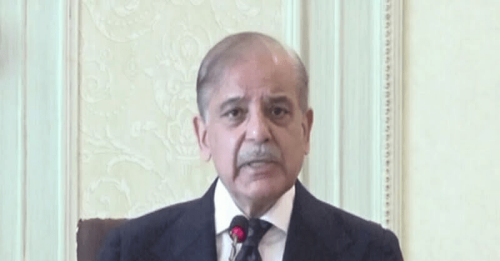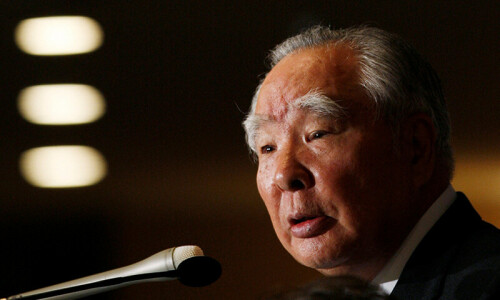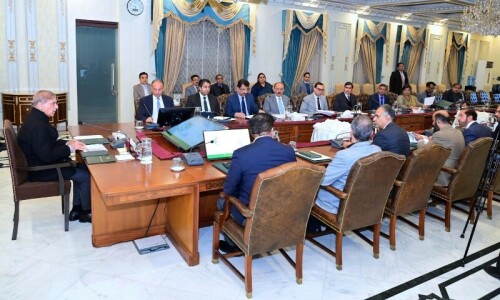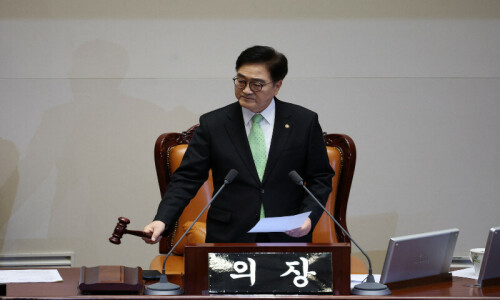
Rich in fields, gardens and pastures in the past, Gandava is known to historians as Qandabil. The modern town of Gandava is situated in the Jhal Magsi District of Balochistan. Presently, Gandava is inhabited by Sindhi, Baloch, Pathan and Brahui tribes and Hindu communities. It stands on a small hill in a flat and desolate plain. According to the Balochistan District Gazetteer Series, Kachhi (1907) Gandava was founded by the Persian King Bahman. Local historians believe that Gandava was founded in 2700 BC. It is situated on Nai Badra or Karee River which runs from the Brahuic Range on the route of the Mula Pass. The people of Mohenjodaro and Harappa were linked with Mesopotamia and Egypt through this pass.
Gandava is dotted with many archaeological sites in Jhal, Gajen and Shoran. The sites of Damb Pathani I, II, III and Kotro were surveyed by British explorers from 1948 to 1957. These sites belong to the Indus Valley Harappa and Jhukar Phases. Some stone weights found from the Gandava citadel belong to Nal Culture dating to 2900 BC. Mounds like Damb Dalu Rai, Ghar, Damb Huzoor Bux, Damb Safrani, Ghoraher Jo Daro and Konhara are also strewn with antiquities and pottery pieces.

According to travel writer Salman Rashid, Achaemenid-Persian King Cyrus the Great visited the eastern provinces’ territories through Mula Pass in the sixth century BC. In 325 BC, Alexander the Great of Macedonia conquered Musicanus, Oxycanus and Porticanus principalities in Upper Sindh. He dispatched his most trusted lieutenant Krateros with 10,000 army and elephants to return to Persia through Khuzdar. Thomas Holdich in The Gates of India (1910) writes that Krateros went back via Qalat and Quetta by the Mula Pass.
The place that Arabs called the land of sweet water — Qandabil — in the Jhal Magsi area of Balochistan has an astonishing history tracing back to almost 5,000 years and a famous general of Alexander the Great
Alexander the Great died in 323 BC at Babylon. His vast empire was divided between his generals, but Sindh continued to be governed by Peithon. It is believed that Peithon developed Gandava due to its military position and geographical importance. In 321 BC, Peithon abandoned Sindh and withdrew to Arachosia (Kandahar). Between 187 to 184 BC, Gandava was held by Bactrian Kings Demetrius and Menander along with the rest of Sindh. Recently, a silver coin of Menander has been discovered from Damb Safrani which is part of the Mir Amir Ali Khan Magsi Antique collection.

Gandava was part of Gedrosia — the Hellenised name of the mountainous part of Sindh and Balochistan, the land from the Indus River to the Strait of Hormuz — and was known as Kottobara at that time. The name of Kottobara appears in Ptolemy’s Map of South Asia drawn in 150 AD. Kottobara was part of Boudaia or Budhia district, located on the banks of River Indus. M.U. Erdosy, in his Map Asia Orientalis (1977), says that Kottobara was a city in Gedrosia.
According to Sir Alexander Cunningham in The Numismatic Chronicle, Vol 8, 1887, Kottobara was the name of a subordinate officer of the Vonones Dynasty of Arachosia. The name Kottobara is inscribed on Indo-Scythian coins issued by the Vonones princes who ruled from Kandahar to Indus. The coins of the Vonones family were found in Afghanistan by East India Company officials in 1841. Kottobara seems to be derived from the Sindhi Kot Bala which means a ‘high fort’. Some scholars have mistakenly identified Kottobara with Quetta, the first record of which is found only from 11th century AD.

After the Greek invasion of Sindh, Gandava progressed under the Scythians and Kushans. Trade and commerce in Gandava flourished under the Sassanians and the Rai Dynasty. It was the capital of the Budhia District which was mostly inhabited by Buddhists.
The earliest recorded history of Gandava begins with the expedition of Chach, the first ruler of the Brahman Dynasty. He marched from Makran and subdued Lasbela, Khuzdar and Qandabil in 641 AD. According to Chachnama, King Chach encamped on the banks of the Sibi River. When food and water supply for the inhabitants of Qandabil ran short, King Chach fixed an annual tribute of 100 horses and 100,000 dirhams on the dwellers. The residents of Gandava gave one year’s levy on the spot. A treaty was made between the local chief and King Chach before the king returned to his capital at Alor. According to Chachnama, the Arab armies reached Qandabil region as early as 644 AD. Al-Muhallab ibn Abi Sufra (632-702), the Arab general from the Azd tribe, conquered Gandava under the Umayyad caliph Mu’awiya (who ruled from 661-680 AD). He served as a governor in Fars, Mosul, Armenia, Khurasan and Azerbaijan.
HOW THE CITY GOT ITS NAME

According to oral tradition, narrated by Syed Anwer Ali Shah of Gandava, when the Arabs first came to Gandava, they saw a stream speedily flowing from the mountains to the city. Thirsty, they started drinking from the stream and said to one another, “Haza Qandabil!” In Arabic, ‘Qand’ means ‘sugar’ and ‘bil’ means ‘bowl’ or ‘pot’. In short, they meant ‘sweet water land’. That is how the place came to be known as Qandabil. From 644 AD until 711 AD, the Qandabil region of Budhia, though subjugated by the Arabs, became a refuge for Arabs fleeing the Umayyad government and was occupied by the Brahman kings of Sindh (The Encyclopedia of Islam, Leiden, 1997).
In 711 AD, Muhammad Bin Qasim advanced from Debal to Sehwan. The governor of Sehwan, Chandram Halah, fled to Budhia but Muhammad Bin Qasim chased him up to Sisam. He was victorious after a two-day battle in which Bachehra, a cousin of King Dahir, was killed along with his chiefs. The rest fled to Bhatlor — a fortified town between Saloj and Qandabil — and from there appealed for pardon and mercy.

Dhol, the cousin of King Dahir, governed Qandabil since 704 AD. Qandabil was renamed “Ganjaba” (abundance of water) during the 15th century. This city developed under the rule of Soomra, Samma, Arghun and Turkhan dynasties. It remained a strategic point during the rule of the Mughals, Kalhoras and Khans. In fact, during the Anglo-Afghan War of 1839, the British Army advanced through Gandava.
The antiquities of Gandava include the Mounds of Lakhpur, Peengher and Kauru. The Mughal Emperor Humayun passed through the country of the Magsis during his exile in 1543. The Ganjaba fort was conquered by Mughal Emperor Akbar’s officers in 1595. Abu‘l-Fazl mentions the fort in Ain-i-Akbari. The last tower of this fortress still stands in Anwer Shah Muhalla. In 1659, Prince Dara Shikoh took shelter with the chief of the Magsis at Khanpur during his last journey to Dhadhar.

The majestic Moti Gohram tomb, locally known as the Taj Mahal of Balochistan, is falling into pieces. The tombs of Ayub Shah Bukhari, Murad Kaleri, and Meeri of Khan-e-Qalat, Jamia Mosque Gandava, a Hindu temple, Syed Noor Shah Hussaini, and the tomb of Mian Saleh, Pauch, Altazai are the best examples of Islamic architecture in the area, while Mirpur, Mian Saleh, Pauch Mosque, Khari fort, Kumbi, Fatehpur, Hathyari, Panjuk Khanpur fort, and Jhal Magsi Graveyard are also places of interest.
Gandava town and its municipal area is developing day by day. There is dire need to address issues like water, electricity, gas, health, education and livelihoods. The Noulang Dam is being constructed on Mula River, 30 km west of Gandava, which will irrigate 47,000 acres of land with a hydropower capacity of 4.4 MW. But authorities should take notice of the crumbling heritage of the area and promote it on a large scale for tourism.

The writer is a freelance journalist and social activist
Published in Dawn, EOS, December 22nd, 2019















































Dear visitor, the comments section is undergoing an overhaul and will return soon.